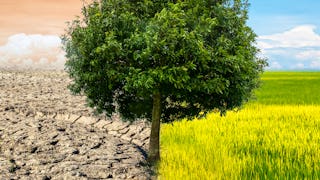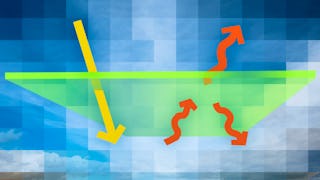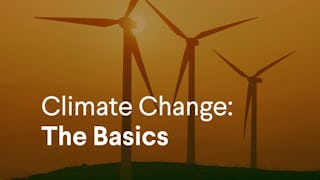This class describes the science of global warming and the forecast for humans’ impact on Earth’s climate. Intended for an audience without much scientific background but a healthy sense of curiosity, the class brings together insights and perspectives from physics, chemistry, biology, earth and atmospheric sciences, and even some economics—all based on a foundation of simple mathematics (algebra).


Global Warming I: The Science and Modeling of Climate Change

Instructor: David Archer
69,513 already enrolled
Included with
(453 reviews)
Skills you'll gain
Details to know

Add to your LinkedIn profile
See how employees at top companies are mastering in-demand skills

There are 12 modules in this course
What you will find in this class.
What's included
1 video4 readings
A primer on how to use units to describe numbers when describing temperature, energy, and light. Even if you don't plan on doing calculations yourself, understanding how units work will help to follow the rest of the lectures in the class. If you are interested in practicing your analysis skills, using units to guide calculations, there are some exercises in the Part II of this class.
What's included
6 videos2 assignments1 peer review
The balance of energy flow, as incoming sunlight and outgoing infrared, allow us to create our first simple climate model, including a simple greenhouse effect. There are two extended exercises in Part II of this class, one an analytical (algebraic) model of the equilibrium temperature of a planet, the other a numerical model of how that temperature might evolve through time.
What's included
2 videos4 assignments
The Layer Model above assumes that the pane of glass representing the atmosphere absorbs all of the infrared radiation that hits it and that it radiates at all infrared wavelengths. In other words, the layer model atmosphere is an infrared blackbody, but transparent in the visible. In reality, greenhouse gases are not "black" at all; they are very choosy about which frequencies of light they absorb and emit. This selective absorption of infrared light by greenhouse gases leads to the band saturation effect, which makes rare, trace gases like methane disproportionally powerful relative to higher-concentration gases like CO₂.
What's included
2 videos1 assignment
The greenhouse effect works because the air in the upper atmosphere is colder than the ground, so that absorption and re-emission of IR by greenhouse gases decreases the amount of energy leaving the planet to space. Here we explore the physics responsible for keeping the upper atmosphere cold.
What's included
4 videos1 assignment
Another property of the real world, missing in our model so far, is that the real world is not everywhere the same temperature, and the heat fluxes to and from space do not necessarily balance at any given time or location. This is because the winds in the atmosphere and the currents in the ocean carry heat around, in general from the hot tropics up to the cold high latitudes.
What's included
4 videos1 assignment
Feedbacks are loops of cause-and-effect that can either stabilize Earth's climate or amplify future climate changes. There is an exercise in Part II of this class where you solve for a planet's temperature by iteration, and in the process demonstrate a runaway ice albedo feedback that might have led to the Snowball Earth climate state 700 million years ago.
What's included
6 videos7 assignments1 peer review
Now we shift gears in a major way — away from climate physics (you now have seen its main ingredients) to the emergent miracle that is the carbon cycle on Earth. Not only is carbon the chemical element of life, it is also the means of storing life's energy. We will look at how carbon cycles through the land, the oceans, and the deep earth, going in and out of the atmosphere -- and how that stabilizes the earth's climate.
What's included
9 videos4 assignments
On the carbon locked up in fossil fuels and what happens when we burn those fuels. In Part II of this class, you can create a simple but somewhat realistic model of Earth's temperature evolution in the coming decades, in response to the release of CO2 (or in the sudden stop of emissions in a scenario called "The world without us").
What's included
7 videos5 assignments2 peer reviews
You have now seen the ideas behind the forecast for a human impact on Earth's climate. The next question is: Do we see it happening today? It turns out that the "smoking gun" for a human impact on climate is the global average temperature record since about the 1970's. In order to interpret that temperature change, we need to consider it within the context of natural climate changes in Earth's geologic past.
What's included
10 videos6 assignments1 peer review
This unit we focus on the potential impacts of continued business-as-usual CO2 emissions. This is also the topic of the Working Group 2 volume of the IPCC reports (the Working Group 1 report is on the scientific basis, which is what we've been studying so far this course). You may find this material distressing, but hang on, because next week we'll go over "Mitigation", which is what it takes to avoid climate change (treated in the Working Group 3 report). Remember that most of the carbon we're worried about is still in the ground, so these impacts are inevitable only if we continue to decide to make them so. In Part II of this class, you can create a simple ice sheet model of your own.
What's included
12 videos9 assignments1 peer review
The last unit of the class finds us considering the options for avoiding, or "mitigating," a human impact on Earth's climate. Bottom line: I think it would be a challenge that humankind could beat if we decided to. If there hypothetically were no more coal on Earth, our potential to alter the climate would be much less. Finding energy sources in that world would not be an existential threat would just be a business opportunity. The hard part, in my opinion, is making that decision.
What's included
8 videos1 reading8 assignments2 peer reviews
Instructor

Offered by
Explore more from Environmental Science and Sustainability
 Status: Free Trial
Status: Free TrialDuke University
 Status: Free Trial
Status: Free TrialEDHEC Business School
 Status: Preview
Status: PreviewThe University of Chicago
 Status: Free Trial
Status: Free TrialCouncil on Foreign Relations
Why people choose Coursera for their career




Learner reviews
453 reviews
- 5 stars
77.31%
- 4 stars
12.77%
- 3 stars
4.40%
- 2 stars
1.54%
- 1 star
3.96%
Showing 3 of 453
Reviewed on Jun 26, 2020
A detailed and really knowledgable course. The course structure and the knowledge shared by Prof. David made learning simple and interesting. The assignments are also very well structured.
Reviewed on Mar 18, 2016
I found this course very interesting and informative and it has helped me understand and debate climate change to a much greater capacity
Reviewed on Feb 22, 2018
Good course! in hindsight i wish i bought the book at the beginning/there were some written summaries/pdfs of the key points.

Open new doors with Coursera Plus
Unlimited access to 10,000+ world-class courses, hands-on projects, and job-ready certificate programs - all included in your subscription
Advance your career with an online degree
Earn a degree from world-class universities - 100% online
Join over 3,400 global companies that choose Coursera for Business
Upskill your employees to excel in the digital economy
Frequently asked questions
To access the course materials, assignments and to earn a Certificate, you will need to purchase the Certificate experience when you enroll in a course. You can try a Free Trial instead, or apply for Financial Aid. The course may offer 'Full Course, No Certificate' instead. This option lets you see all course materials, submit required assessments, and get a final grade. This also means that you will not be able to purchase a Certificate experience.
When you purchase a Certificate you get access to all course materials, including graded assignments. Upon completing the course, your electronic Certificate will be added to your Accomplishments page - from there, you can print your Certificate or add it to your LinkedIn profile.
Yes. In select learning programs, you can apply for financial aid or a scholarship if you can’t afford the enrollment fee. If fin aid or scholarship is available for your learning program selection, you’ll find a link to apply on the description page.
More questions
Financial aid available,
¹ Some assignments in this course are AI-graded. For these assignments, your data will be used in accordance with Coursera's Privacy Notice.